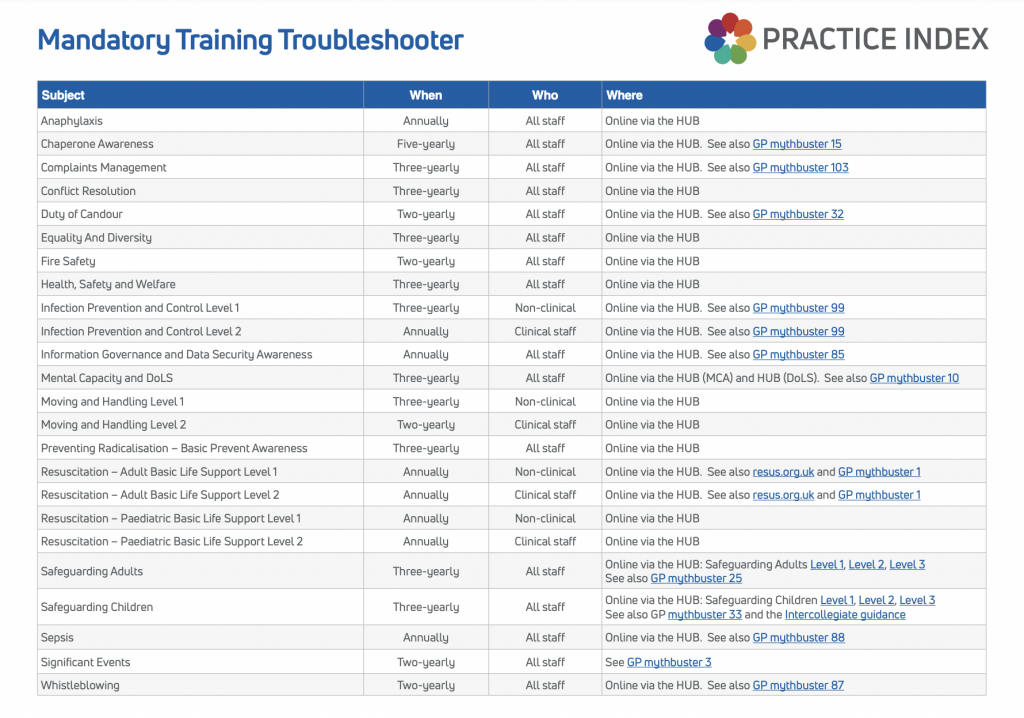There are always lots of questions asked about mandatory training. What does mandatory training cover? Who needs to do what particular training? When do you need to do refresher training? Where is the training to be done? Maybe you’ve also been asked, “Why do I need to do it?” If you’re left thinking, “I can’t explain” (as ‘The Who’ once sang), then you’re certainly not alone. It’s a topic we have covered in the past, but what are the latest guidelines?
Let’s start with who needs to do mandatory training. All staff – that is, clinical, non-clinical, locum or agency staff – will be expected to have completed the necessary mandatory training. You’ll also be expected to have sought assurance that any ARRS staff working at your practice have completed mandatory training too.
So, who is it that decides what training your team needs to do, and on what basis do they make that decision?
Well, that’s you (well, your practice)! CQC GP mythbuster 70 advises that the “CQC does not have a list of mandatory training for members of the GP practice team”. I can almost hear your cries of, “That’s crazy!” and “They’re the regulator; it should be them!” Well, to a degree, yes, but we all know that every practice is different, having different patient groups and different responsibilities. Some are urban, some rural, some completely remote…
There are many variations to take into consideration.
However, you’re not totally cast adrift as the CQC does offer some examples. They’ll expect to see evidence of the following training:
- Basic Life Support
- Infection Prevention and Control
- Fire Safety
- Mental Capacity Act and Deprivation of Liberty Safeguarding
- Safeguarding Adults and Children
But if you think that’s all you need to do, think again, as there’s much more to consider. So, if you’re asked the “Why do I need to do it?” question, it’s because, as a provider of regulated activities, you need to ensure that each member of your team has the necessary skills, qualifications, knowledge and experience to do their job safely and effectively. You’ll need to provide evidence of how you identify the learning needs of your team and how you ensure that your team completes the necessary training.
Bearing this in mind, let’s now look at the when, the who and the where; this is what’s recommended. Remember, you’ll need to determine what training is needed at your practice. If you decide not to have staff complete certain aspects of training, best practice would indicate that you should undertake a risk assessment to justify your decision.
Don’t forget about your members who have specialist skills, such as nurses who take samples as part of the cervical screening programme; you’ll need to make sure they’ve completed the required specialist training.
As you can see, there’s a lot to consider. And just so you “Won’t get fooled again” (another ‘Who’ song), let me dispel some common myths, such as BLS must be delivered face to face. BLS can be delivered virtually so long as there’s hands-on practice using a training manikin. Just check out the link to the Resuscitation Council UK to learn more.
Also, don’t be fooled into thinking that chaperone training and chaperone awareness are the same thing. They aren’t! Chaperone awareness explains what the role of the chaperone is in general practice. Whereas chaperone training is training for those staff who act as chaperones – they’ll need a DBS check too.
So now that you know who needs to do what, let’s consider evidence. You’ll need to be able to demonstrate, ideally at a glance, the current status of staff training. I’d suggest using Learning Manager on the HUB, which enables you to download CQC-ready reports and export staff training records too.
Alternatively, you can use a spreadsheet that shows the RAG (Red, Amber, Green) status of staff training, including the date completed, the due date and a hyperlink to evidence such as a certificate of completion. This useful table shows which courses are required for which job roles.
The BLUF (bottom line up front) is that you need to ensure you have enough qualified, competent, skilled and experienced staff to always meet the needs of your patient population.
You can download the Mandatory Training Troubleshooter table for your office wall or staff room noticeboard here free of charge.
If you need to keep up to date with training, including automated reminders when your team need to refresh their learning, sign up to Practice Index Learning – it’ll put you in control of all mandatory courses for your surgery.






0 Comments